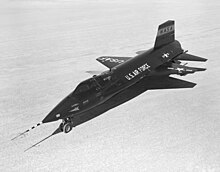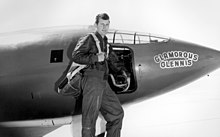Rocket plane

A rocket plane is an aircraft powered by a rocket engine.
Definition
Propulsion is generated by a gas jet that leaves the engine through a nozzle . A rocket plane is used to achieve very high flight performances, such as speed records or extreme altitudes. The high performance of the rocket engine and the low weight of the actual drive lead to outstanding performance data.
In the Russian language the term Raketoplan (Ракетоплан) is used. It is used both for rocket planes that move exclusively in the earth's atmosphere and for "rocket planes" that are used in space . Raketoplan exclusively refers to spacecraft that use the aerodynamic capabilities of aircraft at least on re-entry and thus differ from space capsules . In the German-speaking area, the term space glider or space shuttle is more common nowadays for this second category .
history
The first flight with a rocket-powered aircraft was carried out by Fritz Stamer on June 11, 1928 in a Lippisch duck on the Wasserkuppe. On September 30, 1929, von Opel flew the "Opel-Hatry 1" designed by Julius Hatry at Frankfurt-Rebstock airfield, but the aircraft, powered by 16 powder rockets, was severely damaged on landing. Since the German piston engine development in the mid-1930s fell short of international standards, the military showed great interest in the new drive technology. First, a Fw 56 "Stösser" was converted to an additional liquid rocket motor . At the Heinkelwerke , installation tests with more powerful liquid rocket motors were carried out by Wernher von Braun and Hellmuth Walter on a number of He-112 cells and these were later tested by Erich Warsitz in flight, which also resulted in flights with the piston motor switched off.
The Heinkel He 176 , which emerged from these preliminary tests and which flew for the first time on June 20, 1939, is regarded as the first self-launching and fully functional rocket aircraft .
However, the development was advanced in many countries. The new technology was further developed in the Third Reich and led to the first military missile aircraft, the Messerschmitt Me 163 . The first vertical take-off of a rocket aircraft took place on March 1, 1945 with a Bachem Ba 349 , but ended fatally for the pilot. In the USSR , the Bolchowitinow BI-1 was prepared for series production as early as 1942 , but was discontinued due to unrecoverable defects in the model. Due to the fact that rocket planes have to carry the oxidizer in addition to the fuel and the resulting system-related short range, there was no further military application after the Second World War .
However, in the 1940s the USA started a series of tests with German rocket technology, which ultimately led to the first proven manned supersonic flight with the Bell X-1 .
The USA then made further efforts to gain new knowledge in the field of military technology through the rocket aircraft. The conclusion of this development was the North American X-15 , which carried out numerous flights in the high-speed range above Mach 5.
One of the few current developments is the SpaceShipOne .
Starting procedure
Rocket aircraft either take off from runways like conventional aircraft or are brought to the required take-off altitude by a carrier aircraft if the aircraft is not capable of self-launching. In rare cases, the take-off was also from a vertical position.
Rocket aircraft taking off from carrier aircraft
- DFS 228
- DFS 346
- Bell X-1
- North American X-15
- SpaceShipOne
- Douglas D-558-II
- Bell X-2
- Yokosuka MXY-7
- OKB-2 346
- Korolyov RP-318
- BI-8
- 5 (airplane)
Rocket planes that take off like conventional planes
- Lippisch duck
- Opel-Sander RAK.1
- Heinkel He 176
- Messerschmitt Me 163
- Mitsubishi J8M
- Bolkhovitinov BI-1
- Mikoyan-Gurevich I-270
- Bell X-1
Rocket planes that take off vertically (tail down)
Projects
Modelling
There are also rocket-powered model airplanes. As a rule, these start vertically and fly as a glider after the rocket burns down. Remote-controlled models are also available.
See also
literature
- Joachim Dressel, Manfred Griehl: The German rocket planes 1935-1945. The development of a revolutionary technique. Weltbild Verlag, Augsburg 1995, ISBN 3-89350-692-6

